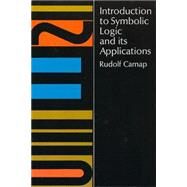Introduction to Symbolic Logic and Its Applications
, by Carnap, Rudolf- ISBN: 9780486604534 | 0486604535
- Cover: Paperback
- Copyright: 11/2/2011
Chapter A. The simple language A
1. The problem of symbolic logic
a. The purpose of symbolic language
b. The development of symbolic logic
2 Individual constants and predicates
a. Individual constants and predicates
b. Sentential constants
c. Illustrative predicates
3 Sentential connectives
a. Descriptive and logical signs
b. Connective signs
c. Omission of parentheses
d. Exercises
4. Truth-tables
a. Truth-tables
b. Truth-conditions and meaning
5. L-concepts
a. Tautologies
b. Range and L-truth
6. L-implication and L-equivalence
a. L-implication and L-equivalence
b. Content
c. Classes of sentences
d. Examples and exercises
7. Sentential variables
a. Variables and sentential formulas
b. Sentential variables
8. Sentential formulas that are tautologies
a. Conditional formulas that are tautologies
b. Interchangeability
c. Biconditional formulas that are tautologies
d. Derivations
9. Universal and existential sentences
a. Individual variables and quantifiers
b. Multiple quantification
c. Universal conditionals
d. Translation from the word-langage
10. Predicate variables
a. Predicate variables
b. Intensions and extensions
11. Value-assignments
12. Substitutions
a. Substitutions for sentential variables
b. Substitutions for individual variables
c. Substitutions for predicate variables
d. Theorems on substitutions
e. Example and exercises
13. Theorems on quantifiers
14. L-true formulas with quantifiers
a. L-true conditionals
b. L-true biconditionals
c. Exercises
15. Definitions
a. Interchangeability
b. Definitions
c. Examples
16. Predicates of higher levels
a. Predicates and predicate variables of different levels
b. Raising levels
c. Examples and exercises
17. Identity. Cardinal numbers
a. Identity
b. Examples and exercises
c. Cardinal numbers
18. Functors
a. Functors. Domains of a relation
b. Conditions permitting the introduction of functors
19. Ismorphism
Chapter B. The language B
20. Semantical and syntactical systems
21. Rules of formation for language B
a. The language B
b. The system of types
c. Russell's antinomy
21. Rules of formation for language B-continued
d. Sentential formulas and sentences in B
e. Definitions in B
22. Rules of transformation for language B
a. Primitive sentence schemata
b. Explanatory notes on the separate primitive sentences
c. Rules of inference
23. Proofs and derivations in language B
a. Proofs
b. Derivations
24. Theorems on provability and derivability in language B
a. General theorems for B
b. Interchangeability
25. The semantical system for language B
a. Value-assignments and evaluations
b. Rules of designation
c. Truth
26. Relations between syntactical and semantical systems
a. Interpretation of a language
b. On the possibility of a formalization of syntax and semantics
Chapter C. The extended language C
27. The language C
28. Compound predicate expressions
a. Predicate expressions
b. Universality
c. Class terminology
d. Exercises
29. Identity. Extensionality
a. Identity
b. Regarding the types of logical constants
c. Extensionality
30. Relative product. Powers of relations
a. Relative product
b. Powers of relations
c. Supplementary remarks
31. Various kinds of relations
a. Representations of relations
b. "Symmetry, transitivity, reflexivity"
c. Theorems about relations
d. Linear order: series and simple order
e. One-oneness
32. "Additional logical predicates, functors and connectives"
a. The null class and the universal class
b. Union class and intersection class
c. Connections between relations and classes
d. Theorems
e. Enumeration classes
33. The ?-operator
a. The ?-operator
b. Rule for the ?-operator
c. Definitions with the help of ?-expressions
d. The R's of b
34. "Equivalence classes, structures, cardinal numbers"
a. Equivalence relations and equivalence classes
b. Structures
c. Cardinal numbers
d. Structural properties
35. Individual descriptions
a. Descriptions
b. Relational descriptions
36. Heredity and ancestral relations
a. Heredity
b. Ancestral relations
c. R-families
37. Finite and infinite
a. Progressions
b. Sum and predecessor relation
c. Inductive cardinal numbers
d. Reflexive classes
e. Assumption of infinity
38. Continuity
a. "Well-ordered relations, dense relations, rational orders"
b. Dedekind continuity and Cantor continuity
PART TWO Application of symbolic logic
Chapter D. Forms and methods of the construction of languages
39. Thing languages
a. Things and their slices
b. Three forms of the thing language; language form I
c. Language form II
d. Language form III
40. Coordinate languages
a. Coordinate language with natural numbers
b. Recursive definitions
c. Coordinate language with integers
d. Real numbers
41. Quantitative concepts
a. Quantitative concepts in thing languages
b. Formulation of laws
c. Quantitative concepts in coordinate languages
42. The axiomatic method
a. Axioms and theorems
b. Formalization and symbolization; interpretations and models
c. "Consitency, completeness, monomorphism"
d. The explicity concept
e. Concerning the axiom systems (ASs) in Part Two of this book
Chapter E. Axiom systems (ASs) for set theory and arithmetic
43. AS for set theory
a. The Zermelo-Fraenkel AS
b. The axiom of restriction
&nbs
53. AS involving biological concepts
a. Division and fusion
b. "Hierarchies, cells, organisms"
54. AS for kinship relations
a. Biological concepts of kinship
b. Legal concepts of kinship
Appendix
55. Problems in the application of symbolic logic
a. Set theory and arithmetic
b. Geometry
c. Physics
d. Biology
56. Bibliography
57. General guide to the literature
Index
Symbols of the symbolic language of the metalanguage
The New copy of this book will include any supplemental materials advertised. Please check the title of the book to determine if it should include any access cards, study guides, lab manuals, CDs, etc.
The Used, Rental and eBook copies of this book are not guaranteed to include any supplemental materials. Typically, only the book itself is included. This is true even if the title states it includes any access cards, study guides, lab manuals, CDs, etc.
Digital License
You are licensing a digital product for a set duration. Durations are set forth in the product description, with "Lifetime" typically meaning five (5) years of online access and permanent download to a supported device. All licenses are non-transferable.
More details can be found here.






